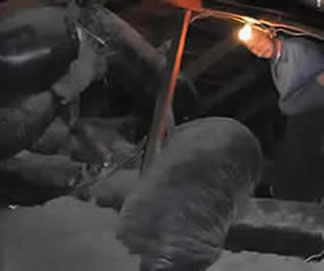Air Ducts: The Wasteful Wormhole
We Never Suspected.
Proctor Engineering Group personnel started researching ducts in the 1980s. In a 1982 study of low income homes, we found 17% had disconnected ducts. John Proctor instituted pilot programs in Colorado low income homes. |
||||
| One of these programs addressed the leakage and conduction losses of duct systems. In conference with Mr. John Tooley, Mr. Proctor came to realize that duct taping duct joints was at best a temporary fix. The solution suggested by Mr. Tooley was mastic and fiber mesh – now commonly used by the best HVAC contractors. |
||||
In 1988 Proctor Engineering personnel and the Solar Energy Research Institute found 44% and 55% savings in homes with the highest amount of duct leakage improvement.
People were not convinced that leaky ducts were a problem, after all, heat still came out of most of the registers in the winter and cool air came out of most of the registers in the summer. So it was a big problem that the occupant could not see. This made dealing with duct systems a hard sell to homeowners, contractors, and utility companies.
 |
One of the challenges was how to test duct leakage. For many years commercial duct systems had specifications on leakage rates and test procedures for high pressure ducts. In the residential and small commercial realm the technology had not been applied. In 1989 Proctor, in consultation with Mr. Gary Nelson developed a prototype duct test rig and used it on small commercial duct systems in Wisconsin. Today at least two companies (The Energy Conservatory and Retrotech) manufacture residential sized duct test rings. |
Another challenge was how to predict the savings from reducing duct leakage (or increased insulation, or smaller surface area). In 1990, based on field research by Proctor, Tooley, Moyer, Parker, Modera, Cummings, Davis, Palmiter, Gammage, Robison, Lambert and others, the United States Department of Energy (DOE) commissioned a study to quantify the energy losses from thermal distribution systems. As a result of that study, DOE worked with the American Society of Heating, Refrigeration and Air Conditioning Engineers (ASHRAE) to establish a test method and calculation methodology to make duct energy loss predictions more reliable. The ASHRAE 152 Standard committee was formed in 1993. The Committee included Proctor, Modera, Nelson, and others. Finding a good balance between practicality and accuracy was a big challenge for the Committee and after 11 tedious years ASHRAE Standard 152 was approved and published in 2004.
The accuracy of the Standard in predicting changes in energy consumption needed to be proven in the field with real homes. The first verification study of the ASHRAE standard was performed in 1998 by Proctor Engineering Group. That study found that the Standard did a good job of predicting changes in energy consumption. All that was needed now was to seal all the ducts in attics and crawlspaces.
Duct sealing programs were initiated by some utilities and adopted by DOE Weatherization agencies. Some of these were highly successful, saving significant heating and cooling energy. At the same time some programs were instituted without technically accurate standards or without either quality control or quality assurance. The Evaluation of Program Standards and Enforcement in Three Duct Sealing Programs shows the difference between well planned and executed programs and their lesser counterparts.
| Typical building codes before the 1990’s specified the ducts should be “substantially airtight” and sometimes included a minimum level of insulation (R 4.2). In the 1990’s, researchers in Florida, Washington, and California pressed code writing authorities for improved specifications on leakage and insulation. In 2001, after California experienced a peak electrical crisis, emergency legislation was passed to immediately update the California Energy Code (Title 24). In that process, Proctor and others succeeded in eliminating the use of cloth backed duct tape and of using building cavities as duct systems. Duct sealing was limited to 6% or less of nominal airflow and is confirmed by independent testing. Many building codes still do not specify duct sealing tests and virtually all fail to specify sufficiently high duct insulation values. |
|
A Short Modern History of Ducts
 |
Two older residential furnaces you may remember are the floor furnace and the gravity feed furnace. The floor furnace was ductless so the warm air (being lighter than the cool air in the house) rose into the house. This produced a very nice warm spot to warm (or burn) your feet. The disadvantage was very large temperature differences around the house. |
Forced air systems were introduced with smaller ducts that have a smaller surface area and less conduction loss. However the insulation was barely improved and joint leaks became more common. Over the years houses have upgraded their wall and ceiling insulation to R-13, R-30, or more, but still use R-6 or less on the ducts. The most common duct system has four problems: |
 |
- Leaky joints -- once sealed with duct tape that has long ago failed.
- Duct runs that are too long – adding unneeded surface area – promoting conduction losses
- Inadequate insulation on the ducts
- Excessive resistance to airflow caused by oversized air conditioners and furnaces.
